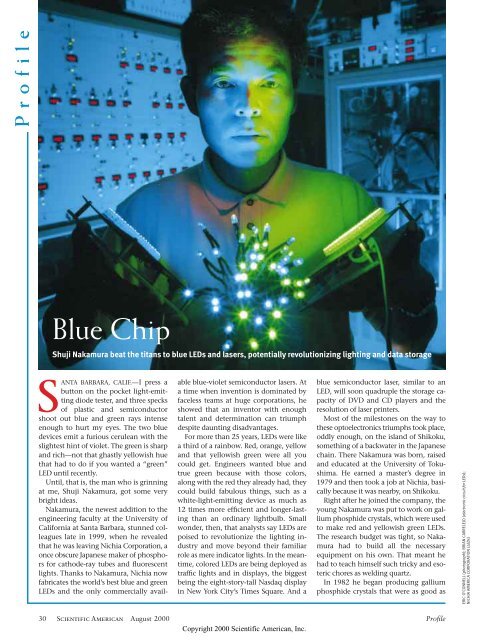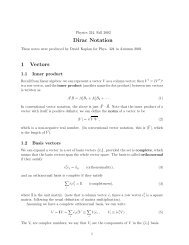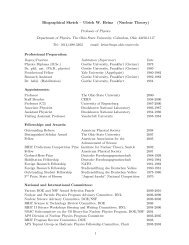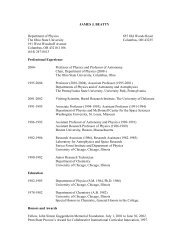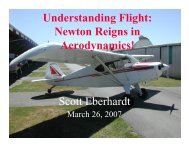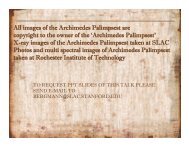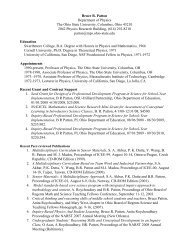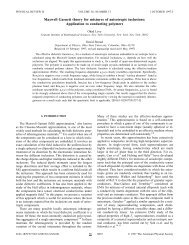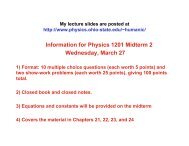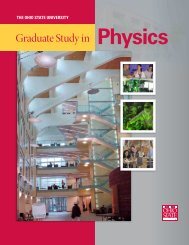Profile: Inventor of the Blue-Light Laser and LED, Shuji Nakamura
Profile: Inventor of the Blue-Light Laser and LED, Shuji Nakamura
Profile: Inventor of the Blue-Light Laser and LED, Shuji Nakamura
You also want an ePaper? Increase the reach of your titles
YUMPU automatically turns print PDFs into web optimized ePapers that Google loves.
<strong>Pr<strong>of</strong>ile</strong><br />
<strong>Blue</strong> Chip<br />
<strong>Shuji</strong> <strong>Nakamura</strong> beat <strong>the</strong> titans to blue <strong>LED</strong>s <strong>and</strong> lasers, potentially revolutionizing lighting <strong>and</strong> data storage<br />
SANTA BARBARA, CALIF.—I press a<br />
button on <strong>the</strong> pocket light-emitting<br />
diode tester, <strong>and</strong> three specks<br />
<strong>of</strong> plastic <strong>and</strong> semiconductor<br />
shoot out blue <strong>and</strong> green rays intense<br />
enough to hurt my eyes. The two blue<br />
devices emit a furious cerulean with <strong>the</strong><br />
slightest hint <strong>of</strong> violet. The green is sharp<br />
<strong>and</strong> rich—not that ghastly yellowish hue<br />
that had to do if you wanted a “green”<br />
<strong>LED</strong> until recently.<br />
Until, that is, <strong>the</strong> man who is grinning<br />
at me, <strong>Shuji</strong> <strong>Nakamura</strong>, got some very<br />
bright ideas.<br />
<strong>Nakamura</strong>, <strong>the</strong> newest addition to <strong>the</strong><br />
engineering faculty at <strong>the</strong> University <strong>of</strong><br />
California at Santa Barbara, stunned colleagues<br />
late in 1999, when he revealed<br />
that he was leaving Nichia Corporation, a<br />
once obscure Japanese maker <strong>of</strong> phosphors<br />
for cathode-ray tubes <strong>and</strong> fluorescent<br />
lights. Thanks to <strong>Nakamura</strong>, Nichia now<br />
fabricates <strong>the</strong> world’s best blue <strong>and</strong> green<br />
<strong>LED</strong>s <strong>and</strong> <strong>the</strong> only commercially avail-<br />
30 Scientific American August 2000<br />
able blue-violet semiconductor lasers. At<br />
a time when invention is dominated by<br />
faceless teams at huge corporations, he<br />
showed that an inventor with enough<br />
talent <strong>and</strong> determination can triumph<br />
despite daunting disadvantages.<br />
For more than 25 years, <strong>LED</strong>s were like<br />
a third <strong>of</strong> a rainbow. Red, orange, yellow<br />
<strong>and</strong> that yellowish green were all you<br />
could get. Engineers wanted blue <strong>and</strong><br />
true green because with those colors,<br />
along with <strong>the</strong> red <strong>the</strong>y already had, <strong>the</strong>y<br />
could build fabulous things, such as a<br />
white-light-emitting device as much as<br />
12 times more efficient <strong>and</strong> longer-lasting<br />
than an ordinary lightbulb. Small<br />
wonder, <strong>the</strong>n, that analysts say <strong>LED</strong>s are<br />
poised to revolutionize <strong>the</strong> lighting industry<br />
<strong>and</strong> move beyond <strong>the</strong>ir familiar<br />
role as mere indicator lights. In <strong>the</strong> meantime,<br />
colored <strong>LED</strong>s are being deployed as<br />
traffic lights <strong>and</strong> in displays, <strong>the</strong> biggest<br />
being <strong>the</strong> eight-story-tall Nasdaq display<br />
in New York City’s Times Square. And a<br />
Copyright 2000 Scientific American, Inc.<br />
blue semiconductor laser, similar to an<br />
<strong>LED</strong>, will soon quadruple <strong>the</strong> storage capacity<br />
<strong>of</strong> DVD <strong>and</strong> CD players <strong>and</strong> <strong>the</strong><br />
resolution <strong>of</strong> laser printers.<br />
Most <strong>of</strong> <strong>the</strong> milestones on <strong>the</strong> way to<br />
<strong>the</strong>se optoelectronics triumphs took place,<br />
oddly enough, on <strong>the</strong> isl<strong>and</strong> <strong>of</strong> Shikoku,<br />
something <strong>of</strong> a backwater in <strong>the</strong> Japanese<br />
chain. There <strong>Nakamura</strong> was born, raised<br />
<strong>and</strong> educated at <strong>the</strong> University <strong>of</strong> Tokushima.<br />
He earned a master’s degree in<br />
1979 <strong>and</strong> <strong>the</strong>n took a job at Nichia, basically<br />
because it was nearby, on Shikoku.<br />
Right after he joined <strong>the</strong> company, <strong>the</strong><br />
young <strong>Nakamura</strong> was put to work on gallium<br />
phosphide crystals, which were used<br />
to make red <strong>and</strong> yellowish green <strong>LED</strong>s.<br />
The research budget was tight, so <strong>Nakamura</strong><br />
had to build all <strong>the</strong> necessary<br />
equipment on his own. That meant he<br />
had to teach himself such tricky <strong>and</strong> esoteric<br />
chores as welding quartz.<br />
In 1982 he began producing gallium<br />
phosphide crystals that were as good as<br />
<strong>Pr<strong>of</strong>ile</strong><br />
ERIC O’CONNELL (photograph); BRIAN CARRELEJO (electronic circuit for <strong>LED</strong>s);<br />
NICHIA AMERICA CORPORATION (<strong>LED</strong>s)
anything Nichia’s larger rivals—including<br />
Sanyo, Sharp, Stanley Electric, Rohm <strong>and</strong><br />
Toshiba—were putting out. Unfortunately,<br />
most customers bought from <strong>the</strong> larger,<br />
well-known companies, leaving Nichia<br />
only a sliver <strong>of</strong> <strong>the</strong> <strong>LED</strong> pie. Over <strong>the</strong><br />
next six years, <strong>Nakamura</strong> went through<br />
essentially <strong>the</strong> same frustrations with gallium<br />
arsenide crystals <strong>and</strong> <strong>the</strong>n with<br />
complete red <strong>and</strong> infrared <strong>LED</strong>s.<br />
Strangely, Nichia’s sales department<br />
blamed <strong>Nakamura</strong> for <strong>the</strong> disappointing<br />
figures, <strong>and</strong> some senior co-workers wanted<br />
him to resign. “I became very angry,”<br />
<strong>Nakamura</strong> recalls. But ra<strong>the</strong>r than let<br />
<strong>the</strong>m drive him away, he resolved to aim<br />
higher. He knew that optoelectronics’<br />
holy grail was a blue-light emitter, <strong>and</strong> he<br />
decided to get into <strong>the</strong> fray.<br />
<strong>Nakamura</strong>’s boss, <strong>the</strong> R&D manager,<br />
thought he was “crazy,” as he tells it, <strong>and</strong><br />
wouldn’t support him. So in January<br />
1988 <strong>Nakamura</strong> bypassed his boss <strong>and</strong><br />
marched into <strong>the</strong> <strong>of</strong>fice <strong>of</strong> Nichia’s CEO,<br />
Nobuo Ogawa, to dem<strong>and</strong> $3.3 million<br />
in research funding <strong>and</strong> a year <strong>of</strong>f to go<br />
to <strong>the</strong> University <strong>of</strong> Florida to study<br />
a semiconductor-fabrication technology<br />
called metallorganic chemical vapor deposition<br />
(MOCVD) that channeled hot<br />
gases to create thin films on substrates.<br />
MOCVD was <strong>the</strong>n emerging as <strong>the</strong> technology<br />
<strong>of</strong> choice for producing certain<br />
exotic semiconductors. It was an outrageous<br />
move in <strong>the</strong> feudal, seniority-based<br />
Japanese corporate system. Much to <strong>Nakamura</strong>’s<br />
amazement, however, Ogawa simply<br />
agreed to all his terms.<br />
At <strong>the</strong> Florida lab, he found that only<br />
parts that could be assembled into an<br />
MOCVD system were available. And it<br />
turned out that <strong>Nakamura</strong> was just <strong>the</strong><br />
guy to do it: lacking a doctorate <strong>and</strong> a list<br />
<strong>of</strong> published papers, <strong>Nakamura</strong> says he<br />
was “treated like an engineer, not a researcher.”<br />
Building <strong>the</strong> MOCVD machine<br />
took him 10 months, working seven days<br />
a week, 16 hours a day.<br />
Returning to Nichia in March 1989 to<br />
begin work on blue-light devices, he had<br />
to choose between <strong>the</strong> two main semiconductor<br />
types. No contest: <strong>Nakamura</strong><br />
picked gallium nitride, because all <strong>the</strong> giants<br />
<strong>of</strong> industry <strong>and</strong> academia were pursuing<br />
zinc selenide, <strong>and</strong> he was sick <strong>of</strong> playing<br />
<strong>the</strong> same game as <strong>the</strong> titans. They<br />
avoided gallium nitride because a necessary<br />
form <strong>of</strong> <strong>the</strong> material (called p-type)<br />
could not be made in commercially useful<br />
amounts.<br />
Over <strong>the</strong> next 10 years, as he coaxed<br />
more <strong>and</strong> more light out <strong>of</strong> gallium nitride<br />
<strong>Pr<strong>of</strong>ile</strong><br />
SHUJI NAKAMURA: FAST FACTS<br />
• Born in Seto-cho, Nishiuwa-gun, Ehime<br />
Prefecture, on Shikoku isl<strong>and</strong>, in 1954<br />
• Wife, Hiroko <strong>Nakamura</strong>, <strong>and</strong> three<br />
daughters, Hitomi, Fumie <strong>and</strong> Arisa<br />
• As a boy, he was inspired by <strong>the</strong> comic<br />
book Tetsuwan Atom, about a robot,<br />
written by <strong>the</strong> great Japanese comic<br />
artist Osamu Tezuka<br />
• Favorite foods: Larmen <strong>and</strong> udon<br />
noodles; uni (sea urchin) sushi<br />
<strong>and</strong> eclipsed his competitors, <strong>Nakamura</strong><br />
put toge<strong>the</strong>r a string <strong>of</strong> achievements that<br />
for genius <strong>and</strong> sheer improbability is as<br />
impressive as any o<strong>the</strong>r accomplishment<br />
in <strong>the</strong> history <strong>of</strong> semiconductor research.<br />
And it is all documented in a trail <strong>of</strong> literature<br />
almost as stunning. Between 1991<br />
<strong>and</strong> 1999 he authored or co-authored 146<br />
technical papers, six books <strong>and</strong> 10 book<br />
chapters on gallium nitride semiconductors.<br />
The output is all <strong>the</strong> more amazing<br />
because it was accomplished in secret:<br />
CEO Ogawa, fearing disclosure <strong>of</strong> secrets,<br />
forbade Nichia employees from publishing<br />
or speaking at conferences. By 1994<br />
<strong>Nakamura</strong>’s body <strong>of</strong> work was so prodigious<br />
that <strong>the</strong> University <strong>of</strong> Tokushima<br />
awarded him a doctorate in engineering.<br />
The foundation <strong>of</strong> <strong>Nakamura</strong>’s success<br />
was a deep underst<strong>and</strong>ing not only <strong>of</strong><br />
semiconductor crystal growth but, more<br />
important, <strong>of</strong> <strong>the</strong> machines that accomplished<br />
it. The active layer in his experimental<br />
<strong>LED</strong>, where electrons <strong>and</strong> electron<br />
deficiencies called holes combined <strong>and</strong> released<br />
photons, was a thin film <strong>of</strong> indium<br />
gallium nitride grown on gallium nitride.<br />
Commercially available MOCVD machines<br />
could not grow an indium gallium<br />
nitride film good enough to emit light<br />
brightly, so <strong>Nakamura</strong> began modifying<br />
his setup. From his years <strong>of</strong> building reactors,<br />
furnaces <strong>and</strong> MOCVD machines, he<br />
knew how to weld quartz—which enabled<br />
him to alter quickly <strong>the</strong> conduits that conveyed<br />
<strong>the</strong> superhot reactants in an<br />
MOCVD machine.<br />
Every morning <strong>Nakamura</strong> modified<br />
<strong>the</strong> reactor. Every afternoon he grew four<br />
or five samples. After about two years, he<br />
hit on <strong>the</strong> configuration that would put<br />
him way ahead <strong>of</strong> <strong>the</strong> pack. In a conventional<br />
MOCVD system, semiconductors<br />
are created as reactant gases flow over a<br />
substrate, parallel to its surface. In <strong>Nakamura</strong>’s<br />
system, one gas flows parallel to<br />
<strong>and</strong> <strong>the</strong> o<strong>the</strong>r flows perpendicularly to<br />
<strong>the</strong> surface. The configuration, which he<br />
calls “two-flow MOCVD,” suppresses<br />
<strong>the</strong>rmal convection currents <strong>and</strong> cools<br />
Copyright 2000 Scientific American, Inc.<br />
<strong>the</strong> reactant gases, leading to more stable<br />
reactions <strong>and</strong> better films.<br />
The o<strong>the</strong>r major obstacle to a massproducible<br />
<strong>LED</strong> fell in 1992, when he invented<br />
a heat-based process to produce<br />
commercial quantities <strong>of</strong> p-type gallium<br />
nitride. But to get a dependable laser, he<br />
still had to find a way to minimize <strong>the</strong><br />
enormous density <strong>of</strong> defects in gallium<br />
nitride crystals. Taking inspiration from<br />
a talk by NEC researchers in 1997, <strong>Nakamura</strong><br />
grew a layer <strong>of</strong> silicon dioxide<br />
strategically within <strong>the</strong> gallium nitride<br />
crystal to block some <strong>of</strong> <strong>the</strong> defects. By<br />
<strong>the</strong> end <strong>of</strong> <strong>the</strong> year he had increased <strong>the</strong><br />
lifetime <strong>of</strong> his blue semiconductor lasers<br />
from about 300 hours to <strong>the</strong> 10,000<br />
hours needed for a commercial product.<br />
Early in 1999 Nichia began selling fivemilliwatt<br />
blue semiconductor lasers <strong>and</strong>,<br />
later, violet ones with a wavelength <strong>of</strong><br />
405 nanometers, <strong>the</strong> shortest ever for a<br />
semiconductor laser. <strong>Nakamura</strong> also produced<br />
blue lasers with power levels above<br />
30 milliwatts; he declines to give a precise<br />
figure (<strong>the</strong> levels necessary for laser<br />
printers are around 50 to 60 milliwatts).<br />
Last October, having done everything<br />
he wanted to with gallium nitride <strong>and</strong><br />
weary <strong>of</strong> a Japanese industrial R&D system<br />
that he characterizes as “communist,”<br />
<strong>Nakamura</strong> decided to leave Nichia.<br />
Although his inventions had swelled<br />
Nichia’s annual pr<strong>of</strong>its from under $100<br />
million to over $400 million, <strong>Nakamura</strong><br />
was being paid only $100,000 a year, he<br />
says. Among <strong>the</strong> 17 job <strong>of</strong>fers he got in<br />
<strong>the</strong> space <strong>of</strong> four weeks was one from a<br />
U.S. company that <strong>of</strong>fered him $500,000 a<br />
year <strong>and</strong> stock options worth $10 million.<br />
“It was unbelievable to me,” he relates.<br />
He was ready to sign with <strong>the</strong> company,<br />
but a pr<strong>of</strong>essor at one <strong>of</strong> <strong>the</strong> universities<br />
that was courting him advised him<br />
that if he took an industrial job, Nichia—<br />
which held <strong>the</strong> patents on all his gallium<br />
nitride breakthroughs—would sue him if<br />
he did anything even remotely related.<br />
After mulling things over, <strong>Nakamura</strong> accepted<br />
an <strong>of</strong>fer from <strong>the</strong> University <strong>of</strong><br />
California at Santa Barbara.<br />
Having earned a nice spot in <strong>the</strong> semiconductor<br />
pan<strong>the</strong>on, <strong>the</strong> 46-year-old <strong>Nakamura</strong><br />
is as restless <strong>and</strong> driven as ever.<br />
Asked what he wants to do now, he replies,<br />
“Here I can start a venture company—in<br />
five or 10 years, if I could invent a new device.”<br />
He says, laughing: “I want to achieve<br />
<strong>the</strong> American dream.” —Glenn Zorpette<br />
For an enhanced <strong>and</strong> more detailed version<br />
<strong>of</strong> this story, go to www.sciam.com<br />
Scientific American August 2000 31<br />
<strong>Pr<strong>of</strong>ile</strong>


